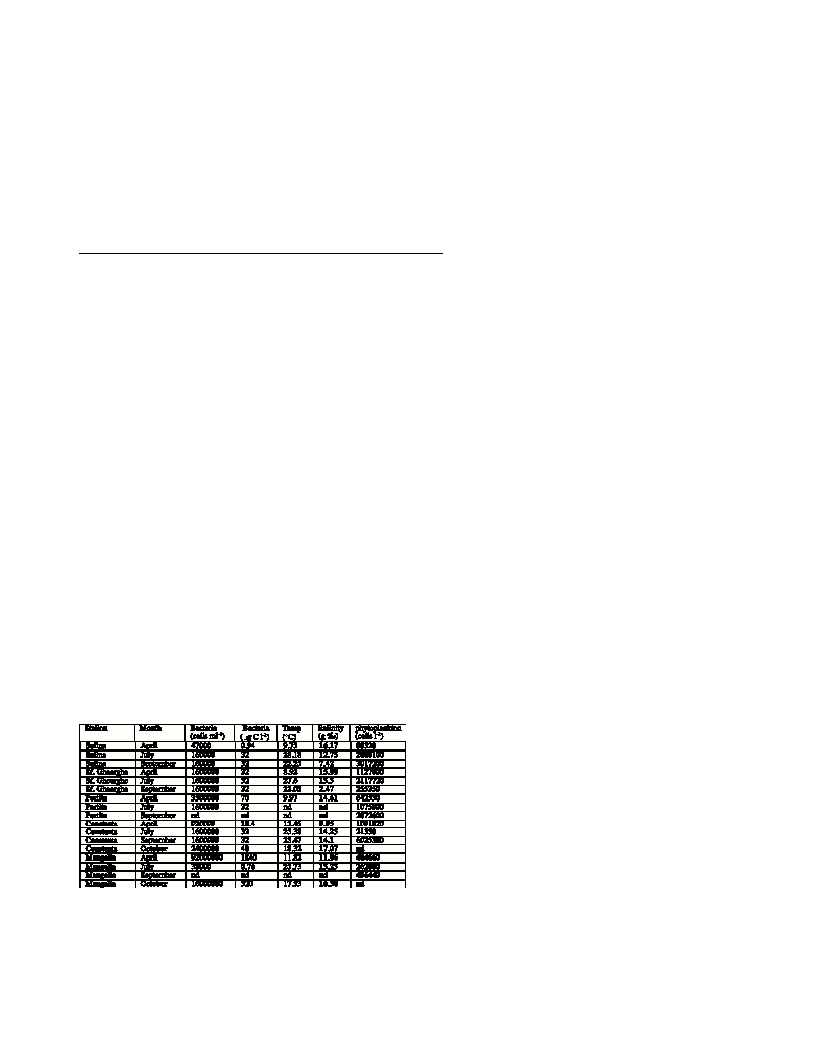Rapp. Comm. int. Mer Médit., 37,2004
292
HETEROTROPHIC BACTERIOPLANKTON DYNAMICS IN RELATIONSHIPS
TO ENVIRONMENTAL FACTORS SPECIFIC FOR THE ROMANIAN BLACK SEA COAST
Elena Stoica
National Institute for Marine Research and Development “Grigore Antipa”, Bd. Mamaia 300, Constanta, Romania, RO-900581,
ellena_stoica@yahoo.co.uk
Abstract
The heterotrophic bacterioplankton dynamics and their relationship with the environmental factors characteristic for Romanian Black Sea coastal
zone were investigated during the year 2002. Bacteriological parameters exhibited more or less distinct temporal variations over the whole
investigation period, with usually higher values during summer. Water temperature varied between 8.3-28.2°C and salinity between 2.47-17.07‰.
Bacterial abundance, assessed by the MPN method, ranged from3.8 x 10
4
cell ml
-1
to 9.2 x 10
7
cell ml
-1
. A strong relationship between bacterial
properties and temperature was found with clear seasonal trends.Also bacterial properties were strongly related to changes in salinity, particularly
for the Romanian coast.
Keywords: bacterioplankton dynamics, environmental factors, Black Sea
Introduction
Microorganisms, especially heterotrophic bacterioplankton, play an
important role in processing of organic matter (1).However, there are
several environmental factors (such as biological, as well as physical
and chemical factors) involved in the control of the dynamics and
bacterial distribution in the coastal zone (2).
Due to its location, the Romanian Black Sea coast is a dynamic
regions characterized by gradients in temperature, salinity and
nutrient concentrations. Moreover, during the past four decades, the
Romanian Black Sea coast has been affected by eutrophication due to
increasing input of anthropogenically-derived nutrients (3).
Therefore, in this study, spatial and temporal patterns of
heterotrophic bacterioplankton abundance and biomass were
investigated and related to environmental factors potentially
controlling bacterial abundance and production. Bacterioplankton
abundance and biomass were determined along the Romanian coast
during spring, summer and autumn 2002 at five sites: Sulina, Sf.
Gheorghe, Portita, Constanta and Manglia. These sites cover two
areas of the Romanian the Black Sea coast with a high anthropogenic
impact: the northern sector (between Sulina and Portita) is under the
in?uence of the Danube river, and the southern sector (from Constanta
to Vama Veche) is affected by industrial and domestic discharges.
The MPN technique on liquid ZoBell medium was used for the
determination of heterotrophic bacterial abundance and is expressed
as cell ml
-1
after 7 days of incubation of 21°C. Bacterial biomass (BB)
was calculated from abundances using 20 fg C cell
-1
(4). Chemical
(salinity), physical (temperature) and biological (total phytoplankton
density) analyses of sea water were also performed (3, 5).
Results and disscution
The results of the microbiological observations along the Romanian
coast at the 5 stations are summarized in Table 1.
Table 1. Heterotrophic bacterioplankton abundance and biomass and
environmental factors in seawater samples (Romanian Black Sea coast)
Heterotrophic bacterial abundance and biomass in the surface
waters along the entire Romanian Black Sea coast were generally
higher in the year 2002 than in previous years (data not shown).
The annual maximum and minimum of heterotrophic bacterial
abundance and biomass in all studied stations was observed in April
(9.2 x 10
7
cell ml
-1
and 1840.0 µg C l
-1
, respectively) and in July
(3.8 x 10
4
ml
-1
and 0.76 µg C l
-1
), respectively, at Mangalia station
(Table1). The abundance and biomass of heterotrophic bacteria in the
northern sector (under the Danube river in?uence) was similar to
those of the southern sector (under the sewage discharges in?uence).
Bacterial abundance and biomass exhibited more or less distinct
seasonal variations. The differences in abundance of bacteria imply
different limiting factors for bacterial populations along the coastal
waters (substrate and nutrients, temperature, oxygen conditions).
During the investigation period, periodical oscillations in the main
biotic and abiotic factors were observed. These ?uctuations seemed to
be interrelated in many instances.
One of the most important factors in?uencing the seasonal
distribution of bacteria in the shallow waters of the Black Sea was
temperature. The pattern of total heterotrophic bacteria correlated
significantly with that of temperature over the entire year.
Besides temperature, organic matter concentration was another
important factor affecting the distribution of the heterotrophic
bacteria. Ours results indicate that in Romanian coastal waters the
sources for organic matter for heterotrophic bacteria are
allochthonous input (continental sources) and autochthonous sources
(produced directly by phytoplankton exudation or indirectly after cell
lysis subsequent to stress conditions).
The enrichment with allochtonous organic material from the land,
led to an increase in heterotrophic bacterial abundance in the stations
at the southern area (Constanta and Mangalia) as well as at the
northern area (Sulina, Sfantu Gheorghe, Portita). Furthermore, the
availability of organic compounds released by primary producers
(phytoplankton) led also to a high level of bacterial population density
(in both coastal area) during the decline of the spring and autumn
algal blooms. Heterotrophic bacteria and total phytoplankton density
were also significant correlated.
References
1-Azam F., Fenchel J.G., Grey J.S., Meyer-Reil L-A., Thingstad F., 1983.
The ecological role of watercolumn microbes in the sea. Ecol. Progr. Ser.,
10: 257-263.
2-Day J.W. Jr, Hall C.A.S., Kemp W.M., Yanez-Arancibia A., 1989.
Estuarine ecology. John Wiley and Sons, New York.
3-Cociasu, A., Dorogan, L., Humborg, C., Popa, L., 1996. Long-term
ecological changes in the Romanian coastal waters of the Black Sea. Mar.
Poll. Bull.,32: 32-38.
4-Lee S., Fuhrman J.A., 1987. Relationships between biovolume and
biomass of naturally derived marine bacterioplankton. Appl. Environ.
Microbiol., 53:1298-1303.
5-Bodeanu N., 1993. Microbial blooms in the Romanian area of the
Black Sea and contemporany eutrophication conditions. Pp: 203-209. In:
Smayda T.J. and Shmizu Y. (eds.), Toxic phytoplankton blooms in the sea.
Elsevier, Amsterdam.

